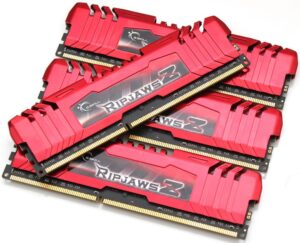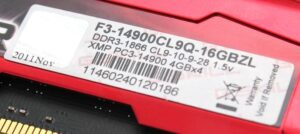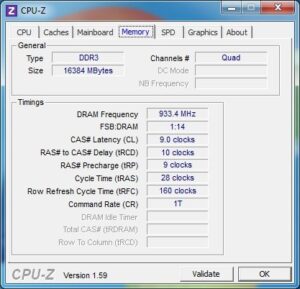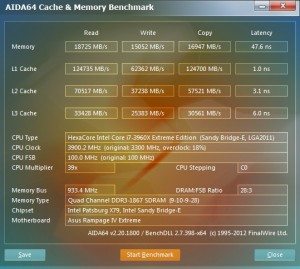G.Skill Ripjaws-Z DDR3 1866MHz 16GB Memory Kit Review
Chris Hadley / 12 years ago

When it comes to purchasing memory, G.Skill may not be one of the first names that springs to mind unless you’re an enthusiast. For those who aren’t, what you may not realise is that G.Skill have been operating for a number of years and their be all and end all about everything is quality.
Quality control is self explained and any company will have a department which makes sure that all of their products are of the best quality possible, however G.Skill have an in-house IC testing department which physically tests each and every one to make sure that they are 100% reliable.
Late last year we took a look at G.Skill’s Ripjaws-X memory kit and we were impressed by its high levels of performance and highly affordable price tag. The Ripjaws-Z is a completely new line for the company and these kits are designed specifically for X79 and its somewhat insane memory bandwidth. The kit we are looking at today comes with a whopping 16GB running at 1866MHz. What we have to remember is that X79 is so much like X58 and is all about bandwidth however we do find that these kits are some of the fastest around with kits with speeds upto a whopping 2500MHz available.
We find the kit in a two sided blister pack with two of the 4GB modules to the front and rear. On the back of the pack there is a brief introduction into quad channel memory and how it is designed specifically for X79 based systems.
Bundled in with the kit we also find a G.Skill case sticker.
This kit consists of four 4GB modules, each with a standard clock speed of 1866MHz and timings of 9-10-9-28 at 1.5V. The red aluminium heat spreaders that we find on the modules have a nice rugged feel to them in comparison to some other modules that we have seen before that have heat spreaders that rise above the level of the PCB. Overall the design of the modules are very stylish and would look great in your system, especially when paired with an Asus ROG based setup.
With the modules being designed for X79, they come in a Quad-channel format and also support XMP profiling.
Test system:
- Asus Rampage IV Extreme
- Intel Core i7 3960
- Gigabyte GeForce GTX 580 SOC
- Corsair H80
- Corsahir HX1050W
- Kingston V+100 128GB SSD
- Lian Li T60
- 3 x AOC E2795VH
We would like to thank AOC, Asus, Corsair, Kingston and Lian Li for supplying us with our test system components.
When we come round to looking at memory kits, naturally we want to make sure that everything is running smoothly and that the motherboard is running the kit at the right speed and timings. When booted, we needed to set our Rampage IV Extreme motherboard to the XMP profile to run the kit at its stock speed and timings of 1866MHz and 9-10-9-28 at 1.5v.
Once in Windows, we see that the XMP profile has as always set the kit to a lower command rate of TT to enforce better stability. Seeing as we want to get the best out of this kit at stock speeds, we went back into the UEFI BIOS and set the command rate to 1T, then gave the setup a once over to ensure it was 100% stable at stock.
As we can see from our test results, the memory kit came up with a read speed of 18725MB/s, write 15052MB/s and copy speed of 16947MB/s with a latency factor of 47.6 ns. In comparison to the stock 2T command rate, the latency is around 4ns lower and all of the read, write and copy speeds did see a little gain of around 100MB/s.
Following the stock results, we were keen to see how much speed we could squeeze out of the memory and how this affected its performance. First of all we decided to try the 2133MHz divider on stock timings, with the voltage upped to 1.65v however this didn’t work on its own and slackening off the timings showed no light either.
From this we decided to overclock the memory manually by adjusting the BCLK and Multiplier to give the CPU a decent speed whilst giving stability to the memory.
After a period of increasing the BCLK and multiplier bit by bit and various combinations of the two, along with slackening off and then tightening up the timings, we managed to get the Ripjaws-Z up to an impressive speed of 2244Mhz with the timings set at 12-12-12-32 1T. At this stage we had the voltage right up to the limit of 1.65V, which is as far as we will take the voltage before we risk damaging the CPU itself and its memory controller.
After achieving this fantastic speed, we then put the kit through the same memory benchmark test in AIDA64. We saw a rise across the board with the speeds, with the read now at 19794MB/s, write at 15890MB/s and copy at 17770MB/s. The latency also dropped slightly to 47.2 ns.
After seeing these results, we knew that the memory must have had more bandwidth in them to offer, and whilst the clock speed is that much higher, Sandy Bridge-E is more focussed on the bandwidth available.
From this we went back into the overclock and focused less on the clock speed but finding the optimum point at which the bandwidth raised to its highest before it started to drop whilst still having a reasonable overclock speed.
We found after a lot of testing that dropping the multiplier down from 39x to 36x, then allowed us the raise the BLCK higher giving a faster CPU overclock, the memory at this point was still overclocked to a respectable 2000MHz and we managed to get the timings back down to the stock levels of 9-10-9-28 1T. Raising the BCLK any higher found a drop in performance and similarly with slightly looser timings.
At this point we found that again all the speeds attained were raised by around the same factor as before, with a read speed now comfortably over the 20000MB/s mark at 20864MB/s, write at 17430MB/s and copy 19052MB/s and the latency even lower at 45 ns. A very impressive set of results all round.
With memory kits in the past, we’ve seen a spread of kits that can offer impressive overclock ranges and the Ripjaws-Z is no exception to this. As we have seen here, the highest clock speed wasn’t the most optimum speed for a Sandy Bridge-E setup, but to still run at a respectable 2000MHz whilst giving nearly 21000MB/s of read speed is impressive in its own right.
As for the kits maximum overclock, whilst its not the biggest gain we’ve seen for a 1866MHz kit, getting a 20% boost over the stock speeds is still a massive achievement.
Going right back to to G.Skill’s ethics with maintaining a high level of quality and not just in the looks and feel but also on an IC level, we can say that the Ripjaws-Z kits are a prime example and they also back this with a lifetime warranty to suit as well.
Price wise the Ripjaws-Z is set at a very competitive rate in respect of the other options that are out there with this particular kit coming in at £139.99.
Over all we are very impressed with the feel, looks and by far the performance that the Ripjaws-Z has to offer for the money, other similar kits are priced around the £200 mark and spending the extra £60 to get those instead, is £60 that could otherwise go towards a faster CPU or GPU.






























